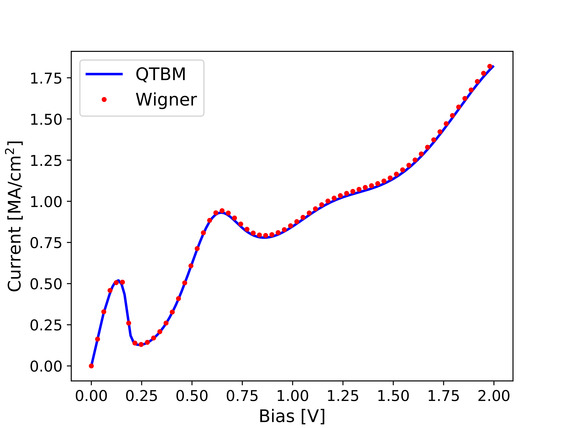 |
|
||||
BiographyRobert Kosik was born in Eisenstadt, Austria, in 1969. He studied technical mathematics at the Technische Universität Wien, where he received the degree of Diplomingenieur in 1996. In 1998 he joined the Institute for Microelectronics at the Technische Universität Wien and received his PhD degree in 2004. His scientific interests include partial differential equations for transport modeling and data analysis in reliability. |
|||||
Numerical Solution of the Constrained Wigner Equation
Quantum electron transport in modern semiconductor devices can be described by a Wigner equation, which is formally similar to the classical Liouville equation (also called Vlasov equation). The existence and uniqueness of solutions to the stationary Wigner equation with classical inflow boundary conditions is a long-standing open problem even in a single spatial dimension.
The stationary Wigner equation has a singularity at zero momentum (k = 0). In order to get a non-singular solution, we impose a constraint on the solution at k = 0, which gives the constrained Wigner equation. In previous work we solved the corresponding constrained sigma equation directly in a least-squares sense using finite differences. Here, we introduce a Petrov-Galerkin method with sine and cosine ansatz functions. This ansatz amounts to a solution in the Fourier domain, i.e. a solution of the constrained Wigner equation. The constraint in the Wigner equation is interpreted as an extra test function and is naturally incorporated into the method. We also incorporate a complex absorbing potential in order to diminish unphysical reflections of outgoing waves.
The spectral method is evaluated by simulating a GaAs/AlGaAs resonant tunneling diode (RTD) and by comparison with the quantum transmitting boundary method (QTBM). The RTD model used in the simulation consists of a 4.5 nm-wide GaAs quantum well and 2.8 nm-wide AlGaAs barrier layers. Doped GaAs electrode layers are included on each side of the device. Outside the electrodes, reservoirs characterized by the thermal equilibrium distributions of carriers are assumed.
We demonstrate the numerical capability of the method by simulating up to a high bias that is beyond the usual operating conditions of the device. The QTBM and the Wigner function model fit almost perfectly up to a bias of 2 V. In order to achieve high accuracy, a coherence length of at least 60 nm must be assumed, and a fine mesh has to be used for the simulation.

Fig. 1: Simulation of a resonant tunneling diode and comparison with QTBM. A weak second resonance near 0.7 V is shown.


